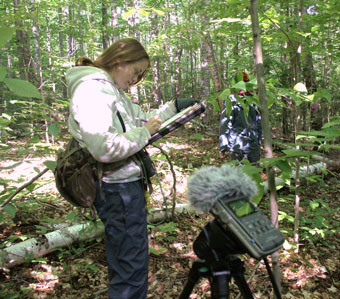Nicolet National Forest Bird Survey
Survey Methods

The Nicolet National Forest Bird Survey uses a standard 10-minute, unlimited distance point count protocol as described by Knutson et al. (Knutson, M.G., N.P. Danz, T.W. Sutherland, and B.R. Gray. 2008. Landbird monitoring protocol for the U.S. Fish and Wildlife Service, Midwest and Northeast Regions, Version1. Biological monitoring team technical report BMT‐2008‐01. La Crosse, Wisconsin: US Fish and Wildlife Service). This is a very simple method where an observer records all birds seen and heard from a stationary point (survey location) during a 10-minute period. A standardized bird point Census Form is used to record the data. It is slightly more complicated than the method itself but is designed to maximize compatibility with other bird census methods and to encourage documentation of all information obtained during the count. Birders are provided with Census Instructions. Approximately 150 sites are surveyed every year. Point counts have been completed one or more years at 522 survey sites. As of 2013, over 63,000 individual breeding birds within 176 species have been counted.
The Bird Survey begins on a Friday, typically during the second weekend in June. Participants in the Bird Survey work in teams, consisting of one or more group leaders who are experts in bird song identification. Other team members participate as timekeeper, navigator, audio recorder operator, or data recorder. Each team is assigned a group of approximately 6-10 sites for the morning surveys. Some are located along roads, while others require a short hike into the target habitat. Road access points are marked in advance, and directions are provided along with topographic maps. In order to reach the sites from headquarters, teams typically leave camp by about 3:45-4:00 (AM!). Most groups complete their assigned sites by approximately 9:00 AM. Upon returning to camp, groups complete the data forms (to facilitate computerized data entry), check the forms for accuracy, and listen to collected bird audio recordings as needed. The rest of the day is free for exploring the forest, visiting with friends, and of course taking a nap.... Several other events, including contests and research presentations, are scheduled on Saturday evening.